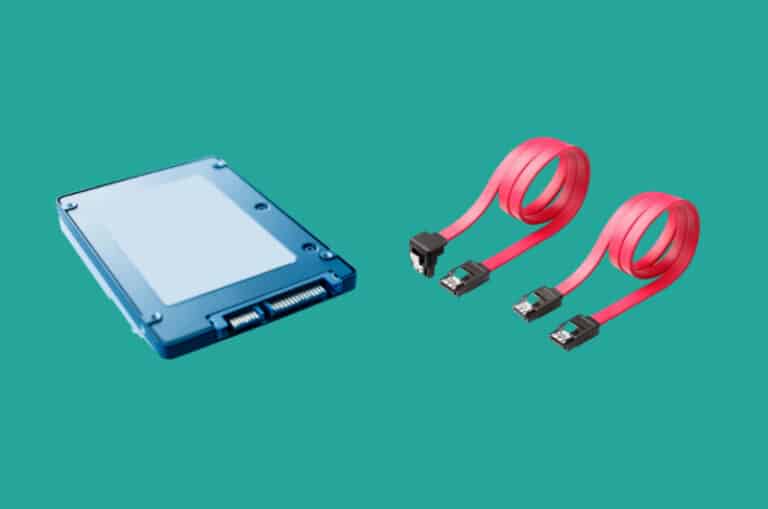Regardless of what anyone might say, SATA is still very much relevant today, especially when we want to increase the storage in our PCs. So here we are, answering the common question – Do SSDs come with SATA cables? Or don’t they? What if they don’t? Keep on reading to find all the answers below.
What is a SATA cable?
First things first, let’s answer your question. What exactly is a SATA cable? This can be a ubiquitous question for anyone new to the world of PCs (we are referring to users who have only dwelled in laptops so far) or even an avid PC user simply looking to upgrade their storage.
SATA stands for Serial Advanced Technology Attachment. In layman’s terms, this simply means a cable that connects drives (optical drives, solid-state drives, hard drives, etc.) to the motherboard.
It’s versatile as different SATA cables have different functions, speeds, specifications, designs, and applications.
What makes them popular is their ability to connect and disconnect while the PC is running, which is something that wasn’t possible before. However, while it is versatile, it is not the easiest to understand for newbies.
Especially if you’re buying SSDs. I’ve seen people buying SSDs with or without these cables. So, what gives? Do SSDs come with SATA cables, or do they not? Let’s find out!
Types of SATA Cables We Get
You’ll find two types of SATA cables on offer. SATA power cables, and SATA data cables.
Explaining SATA Power Cables
These come with a connector. This little plug has 15 pins. All these pins do is supply power. The power cable also comes with thin, rounded wires connected to the connector itself.
Understanding SATA Data Cables
As the name suggests, data cables transfer data and come with a connector with 7 pins. This is used to connect drives to a PC’s motherboard (aka the type of SATA cables we are discussing today).
The first end of this cable connects to the motherboard, and the other end connects to the drive we are trying to transfer the data. The drive’s type, shape, and nature vary from time to time, depending on the user.
Size-wise, these data cables tend to be smaller than power cables, which makes it easy for us to distinguish them.
What are the Different Versions of SATA?
Like most tech products, SATA cables have versions as well. Or generations as some like to call them. With new generations, the speeds, specifications, and bandwidths are updated. These things help them stay up to date with the advanced drives.
SATA I
This is the very first generation of SATA cables, which is why it has the lowest bandwidth of only 150MB/s and operates at a mere 1.5Gb/s.
SATA II
This is the second generation, with improved performance. Here, the bandwidth is double that of SATA I, at 300MB/s, and operates at 3Gb/s.
SATA III
This is the third and latest generation of SATA cables. It has a bandwidth of 600MB/s, double that of the second generation. And the operating power is also a speedy 6Gb/s. What makes this the best is that it is also compatible with older generations, so we can make do with this one cable.
Do SSDs Come with SATA Cables?
There is a lot to discuss as far as SATA cables go. But for now, this will do. So, with the basics of this cable down, let us get down to the main topic of this article – Do these SATA cables come with SSDs?
They are an integral part of connecting them to the PC. Hence, they should technically be included in the package. But here is the catch – in most cases, they aren’t. This is where the confusion begins for many users. We confuse their usefulness with being included in the SSD package.
While they are essential, SATA cables are not included with SSDs or even HDDs, for that matter.
They are included with the motherboard, so that is a place you can look for if you have not already. On the other hand, if the PC you own is pre-built, there is a high chance that the cable was not a part of that package either.
What To Do When DATA Cable Is Not Included With SSD?
Very simple, buy one! It is no rocket science. If that cable is not there, you simply head to your nearest PC store and get one.
Here’s A Tip:
It can be pretty upsetting when we suddenly need the SATA cable and find it does not come with the SSD or motherboard. To prevent this from happening the next time, the best thing is to read the labels!
Often, we do not read the labels in the fine print, where all the details are included. So even if the SATA cable is not included, we are prepared.
What SATA Cable To Buy For SSD?
Now comes the real question. We know that the SATA is omitted, and we have to get one. So, which one? We have it laid down right here.
Look at the Generation
As mentioned above, there are three generations of SATA cables. We recommend going with the latest generation – SATA III. This is because it has a high transmission power and bandwidth, which will work with the latest drives smoothly while being efficient.
Consider the Type as Well
In this case, we are obviously going to go with the SATA data cables, since we are trying to connect it to our SSD.
Installing a SATA cable with the SSD
After finally getting the SATA cable, it is time to install it properly. Follow our simplified guidelines below so you can connect them in a jiffy.
- The first step is to turn the PC off. This is because we will open the PC case to take out the motherboard and power supply. Not turning the power off can be hazardous and can result in an electric shock, so we recommend you do this first!
- Next, we must find the hard disk bays and the motherboard’s SATA ports. In modern boards, we usually find around 6 ports here. Once located, we move to the next step.
- One end of the SATA cable will be L-shaped. First, we will plug this side into any previously located SATA ports. Next, we will connect the other end to our SSD.
- Now we have to move to the Power Supply Unit (PSU). Here, we will also find a cable with an L-shaped end (similar to the one in the SATA cable we saw in the last step). We must now connect this cable to the SSD and install it in the drive bay.
- After all these steps are done, we can put the casing back on and secure it in place.
With the hardware part out of the way, we must move on to the software part. This, too, is just as simple, follow our lead, and you’ll get there in no time!
- Turn on the PC now, as the casing is closed and it is safe to work on again.
- Click on the start button, and then select “Disk Management.” From the scroll bar, we must select Disk 2 (Unallocated).
- Now we have to right-click on “Unallocated,” which will open “New Simple Volume.” Next, we have to follow this “Simple Volume Wizard” and then click on “Next.”
- Here, we can make partitions or skip them and move on to “Next.” Now we have to assign this drive as the E Drive and click “Next” once again.
- Finally, we have to rename the Volume label to “SSD” and then for the last time click “Next.”
- This is the final step, as we click on the “Finish” button. The process is complete!
After these steps, allow some time for the drive to format until we can see the “SSD (E:)” notification come up. We can now close this window and move to “File Explorer.” Here we can see the “SSD (E:)” now.
Final Words
Someone who often deals with computers usually knows the answer to these questions. But for the rest of us, these questions are never-ending with every new step we take. We hope this article has clarified the confusion regarding SATA cables being included with SSDs.
While they do not come with the SSD, SATA cables are cheap. So, if you have it in mind to switch to an SSD or add one, you better get some of these SATA data cables and keep them with you.
Remember to read the fine print when buying SSDs or any other drive, connector, wire, etc., so you know the exact details of what you are getting. And finally, follow these steps to install the SATA cable properly for smooth computing!

Hello Good People! This is Pavel and Welcome to PC Delight!
I’m an Electronics Engineer by profession with a passion for Gaming & PC builds. When I came up with the idea for PC Delight, it was my goal to share & offer the very best PC building ideas to tech-loving people like myself.
Since my school days, I’ve been just addicted to gaming & PCs. That leads me to experiment with various ways around the very niche, resulting in great productivity. And I’m here to share those practical experiences. So that next time you start some experiment with your PC builds or struggle to cope with a certain game, I’m here with the solutions. With these philosophies, I started my journey in 2017 and just kept going.
